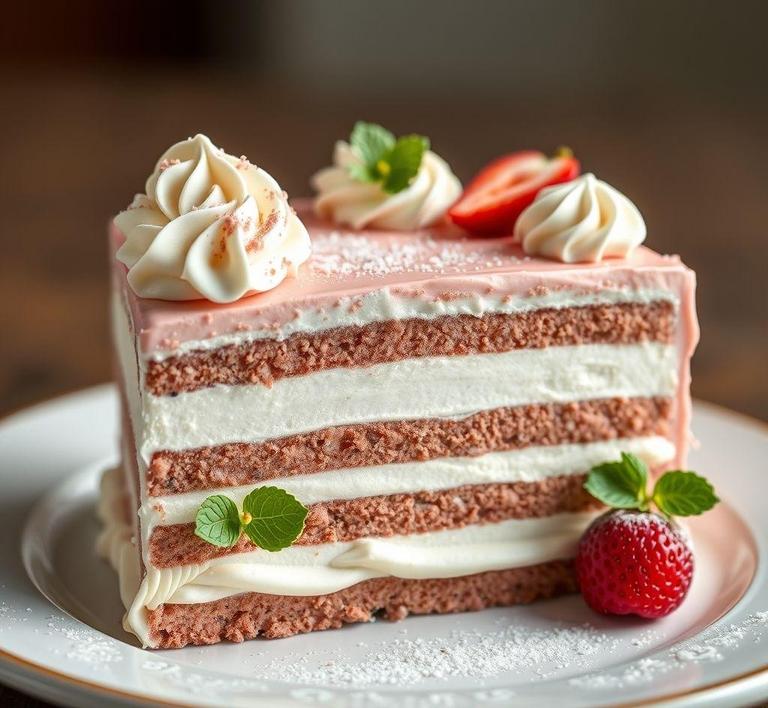If you’ve ever indulged in the deliciously creamy layers of Viennetta, you know that its unique texture and flavor are pure magic. But what happens when you find yourself with a half-eaten cake in the freezer and no one to finish it off right away? Refreezing Viennetta is actually possible and can keep its iconic layers intact, but there’s a bit of a trick to doing it right! In this guide, we’ll take you through the best way to refreeze Viennetta without losing its original deliciousness, so you can keep the dessert party going even after it’s been partially enjoyed!
Can You Refreeze Viennetta?

Refreezing Viennetta, the iconic layered ice cream dessert with its wavy chocolate and vanilla ice cream, might seem like a simple enough question, but it comes with a bit of nuance. Typically, Viennetta is a premium dessert made to be enjoyed in one sitting or over a few days, but like many frozen treats, it may sometimes be left out, either intentionally or by mistake. So, what happens if you find yourself wondering if you can refreeze Viennetta?
The short answer is yes, you can refreeze Viennetta, but there are some important considerations. First off, it’s crucial to understand that once ice cream or any frozen dessert starts to thaw and melt, the structure of the dessert changes. The freezing process locks in the texture, flavor, and visual appeal, but once it melts, the water content in the ice cream can start to separate from the fats and sugars, leading to a less-than-ideal refreeze. When you refreeze it, the ice crystals that form during the freezing process can become larger and disrupt the smooth, creamy texture that Viennetta is known for.
Another thing to consider is how many times the Viennetta has been thawed and refrozen. The more times it’s subjected to this process, the worse the texture and flavor can become. In some cases, the ice cream may even lose its original consistency, becoming grainy or icy. So, while it’s not impossible to refreeze Viennetta, there are definite risks involved.
How To Refreeze Viennetta?
Refreezing Viennetta requires care and attention to detail in order to maintain as much of its original flavor and texture as possible. If you find yourself in a situation where you’ve had to defrost it, or you’ve taken out too much, here’s a guide to ensure you’re doing it as effectively as you can.
1. Check The Condition Of The Viennetta
Before you even think about refreezing, inspect the dessert. Has it melted completely or is it still slightly firm? If it’s only partially thawed, you’re in a better position to preserve its quality. If it’s fully melted, you might want to reconsider refreezing, as the texture may already be compromised.
2. Wrap It Properly
If you’ve decided to proceed with refreezing, it’s essential to wrap the Viennetta correctly. Use cling film or plastic wrap to cover it securely. Make sure the wrap touches the surface of the dessert to prevent any ice crystals from forming on the surface. If you want to add an extra layer of protection, you can then place it inside an airtight container or wrap it in aluminum foil.
3. Set Your Freezer Temperature Correctly
Your freezer should be set to the coldest temperature possible. This helps to freeze the dessert quickly, minimizing the formation of large ice crystals. The quicker it freezes, the better the overall quality when you eventually take it out.
4. Be Mindful Of Refreeze Time
Try not to leave it in the freezer for an extended period. Ice cream in general can lose its flavor and texture after being refrozen for a long time, so plan on finishing the dessert relatively soon after refreezing it. A few days is usually the maximum recommended time.
5. Let It Sit Before Serving
Once you’ve refrozen it, allow it to sit for a few minutes outside the freezer before serving. This helps soften the dessert slightly, making it easier to cut through the layers without losing the shape.
Quality Impact
Refreezing Viennetta does come with some noticeable changes in quality, and the dessert’s allure can be significantly impacted. The primary concerns that arise when refreezing Viennetta are the texture and the flavor.
Texture
One of the hallmark features of Viennetta is its luxurious texture, with smooth vanilla ice cream layers separated by crunchy chocolate layers. However, when the dessert is refrozen, the texture may be compromised. The melting and refreezing process leads to the formation of ice crystals that can disrupt the creamy consistency of the ice cream. Instead of the smooth, soft bite that you initially experience, the refrozen Viennetta might feel more icy, gritty, or even somewhat rubbery. The once-melt-in-your-mouth effect could turn into a slightly denser experience.
The chocolate layers, too, might not have the same appealing crispness that they had before being thawed. They could turn soft or develop a "chewy" texture that’s less desirable.
Flavor
Refreezing can also alter the flavor profile of Viennetta. While the ice cream’s taste might still be sweet, the freshness and creaminess may begin to fade. The sugar and fat in the ice cream are more likely to separate when refrozen, which might lead to a subtle change in taste. Additionally, some flavor notes, like the vanilla and chocolate balance, could seem slightly muted. That high-end creamy indulgence might not shine as brightly once the dessert has gone through the freezing and thawing cycle.
Visual Appeal
One of the first things you might notice when you refreeze Viennetta is how it looks. The layers that were once crisp and defined could start to blur together, creating a less visually attractive dessert. The chocolate might lose its glossy sheen, and the layers may not be as neatly separated as they once were. If you’re someone who eats with their eyes first, this might be one of the biggest drawbacks.
While it’s entirely possible to refreeze Viennetta, doing so can significantly impact the dessert’s texture, flavor, and overall appeal. The creamy layers, once perfectly crafted, might become icy and grainy, and the smooth chocolate layers could lose their signature crunch. If you’ve only partially thawed the dessert, it’s generally safe to refreeze, but it’s a good idea to consume it sooner rather than later. If it’s already fully thawed, however, the refreezing process may not be worth it.
Ultimately, the decision to refreeze Viennetta comes down to your willingness to accept a potential decline in quality for the sake of not wasting food. For those who prioritize the full, decadent experience of this dessert, it might be best to enjoy it fresh, without risking the texture and flavor compromise that comes with refreezing. After all, Viennetta was meant to be a special treat, best enjoyed at its finest.
Is It Safe To Refreeze Viennetta?
Refreezing Viennetta, the iconic layered ice cream dessert, presents both challenges and considerations when it comes to food safety, texture, and taste. Technically speaking, it is safe to refreeze Viennetta if the dessert has been stored at a consistent freezing temperature and hasn’t been left at room temperature for extended periods. However, just because something is safe doesn’t necessarily mean it’s ideal. The structure of Viennetta, which is made up of thin layers of vanilla ice cream interspersed with delicate chocolate ribbons, is highly susceptible to changes in temperature. When refrozen, this could lead to noticeable changes in both texture and flavor.
The main issue with refreezing Viennetta is that the process of thawing and refreezing ice cream allows the formation of larger ice crystals, which can affect the smoothness of the dessert. This is especially problematic for Viennetta, where the visual appeal and smooth mouthfeel are key components of its enjoyment. Refreezing can also cause some degradation of the chocolate layers, making them a little more brittle and less creamy. Additionally, the longer the ice cream has been thawed or stored improperly, the higher the risk of bacterial growth, so if you’ve thawed your Viennetta improperly or left it out for too long, it might not be safe to refreeze.
In short, while you can refreeze Viennetta under the right conditions, doing so may compromise its original quality. For best results, limit refreezing and consume it within a reasonable time frame to preserve its signature characteristics.
Signs That Viennetta Should Not Be Refrozen
While some ice cream desserts may tolerate the refreezing process better than others, there are a few clear signs that Viennetta should not be refrozen. These indicators can help you avoid potential safety issues or compromised flavor.
- Excessive Softening or Melting: If Viennetta has been left out at room temperature for more than a couple of hours or has begun to melt significantly, the risk of bacterial contamination increases. Once ice cream has thawed completely, refreezing may not only affect the texture, but it could also lead to health concerns. If the dessert is too soft, particularly in the center, it’s best to discard it, as it may not be safe to refreeze.
- Visible Ice Crystals or Frost: Large, visible ice crystals forming on the surface of your Viennetta indicates that it has partially thawed and refrozen before. This means the texture will likely be compromised and the layers of ice cream and chocolate may separate. If the ice crystals are significant, it’s a good indication that the dessert has already gone through an improper freezing cycle and might not recover well.
- Off Smell or Discoloration: Any unusual odor or discoloration in the Viennetta, such as an off or sour smell, or yellowing of the ice cream, suggests that the dessert has been exposed to fluctuating temperatures for too long. This could point to bacterial growth or degradation of the flavor compounds, making it unsafe to refreeze or consume.
- Over-extended Storage Time: If the Viennetta has been sitting in the freezer for an extended period beyond the recommended storage guidelines, it’s best not to risk refreezing. Ice cream typically has a shelf life of 1-2 months in a home freezer, and after that, its quality significantly deteriorates.
Common Refreezing Mistakes
Refreezing Viennetta, or any ice cream for that matter, comes with a few common mistakes that can exacerbate the issues of texture, safety, and quality. Here are some of the most frequent errors people make when refreezing desserts like Viennetta:
- Thawing at Room Temperature for Too Long: The most significant mistake is allowing Viennetta to thaw at room temperature for too long. While it may be tempting to take it out and let it soften for easier serving, doing so for an extended period can cause it to melt unevenly. The ice cream’s texture can suffer, and refreezing the dessert after it has thawed for too long can lead to ice crystals and poor consistency.
- Frequent Thawing and Refreezing: Constantly taking Viennetta in and out of the freezer is a major mistake. Every time it is thawed, the texture degrades, and refreezing it creates bigger ice crystals. The layers of vanilla ice cream and chocolate ribbons will lose their delicate structure, turning the dessert into a less appealing mess. It’s crucial to limit the number of thaw-refreeze cycles to maintain its original quality.
- Improper Storage Conditions: Storing Viennetta in a freezer that fluctuates in temperature or is opened and closed frequently can affect the quality of the dessert. The temperature should remain consistently at or below 0°F (-18°C). If your freezer has temperature fluctuations, the texture of the ice cream will degrade faster, leading to issues when you attempt to refreeze it. Always ensure it’s wrapped tightly in its original packaging or an airtight container to avoid freezer burn.
- Not Allowing Viennetta to Fully Freeze Again: After refreezing, some people make the mistake of serving it too soon before it has reached the proper freezing temperature. Ice cream needs to be fully frozen to maintain the correct texture. If it’s served too soft, it won’t have that signature firm, creamy feel.
Tips And Tricks
While refreezing Viennetta may never give you the same experience as enjoying it fresh, there are a few tips and tricks you can use to maximize its quality and ensure a smoother process.
- Freeze in Smaller Portions: If you know you won’t be able to finish the entire Viennetta in one sitting, consider cutting it into smaller portions before refreezing. This reduces the chances of thawing and refreezing the entire dessert repeatedly. You can take out only what you need, ensuring the rest stays intact.
- Use a Freezer with a Stable Temperature: To avoid temperature fluctuations, store your Viennetta in a deep freezer, which is typically more reliable in maintaining a constant temperature compared to a regular freezer compartment in a fridge. This will help preserve its texture and flavor.
- Wrap it Properly: If you need to refreeze Viennetta, wrap it tightly in plastic wrap and foil or place it in an airtight container. This prevents air from reaching the ice cream and helps minimize the formation of ice crystals on the surface.
- Avoid Long-Term Storage: Don’t store Viennetta in the freezer for months on end. Even if it’s refrozen properly, the dessert will start to lose its original flavor and texture. Aim to consume it within 1-2 months of purchase for the best experience.
- Slow Thawing: If you need to thaw Viennetta before serving, do so slowly in the refrigerator instead of at room temperature. This helps the dessert retain its structure and prevents it from melting unevenly.
Conclusion
While refreezing Viennetta may be possible, it’s a practice best avoided if you want to preserve its premium taste and texture. The dessert’s layered design and delicate ice cream can suffer from changes in temperature, leading to ice crystals, a loss of creaminess, and an overall less enjoyable eating experience. However, if you must refreeze Viennetta, follow best practices like wrapping it properly, storing it at a consistent freezing temperature, and limiting the number of times it’s thawed and refrozen. With a little care, you can enjoy this iconic dessert even after a little time in the freezer, but always be mindful of the signs that indicate it may be better to let go and enjoy it fresh.


